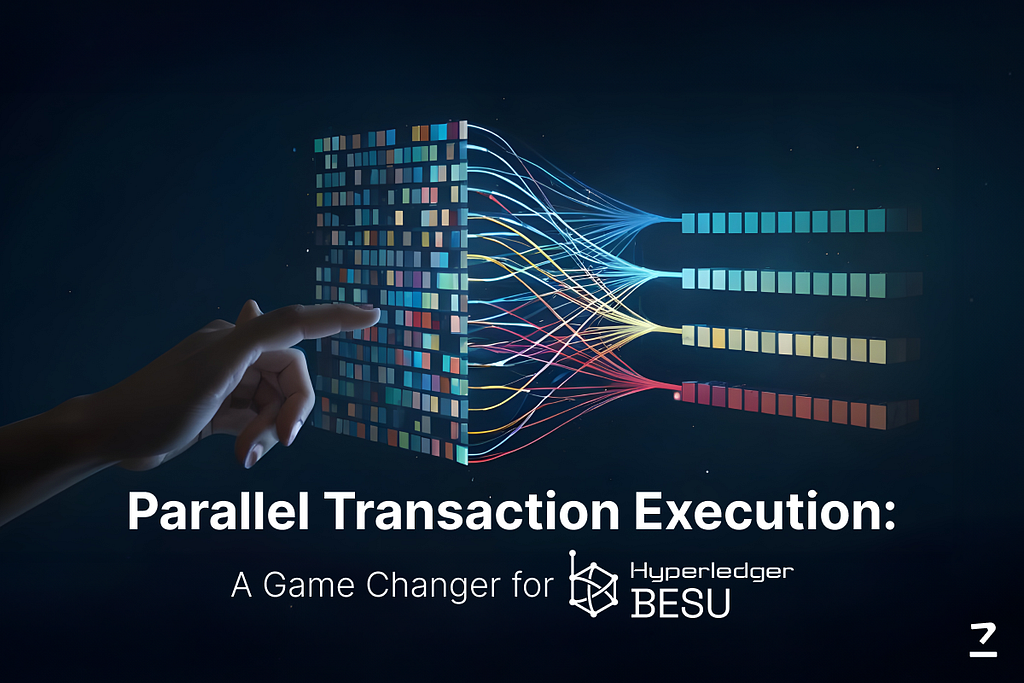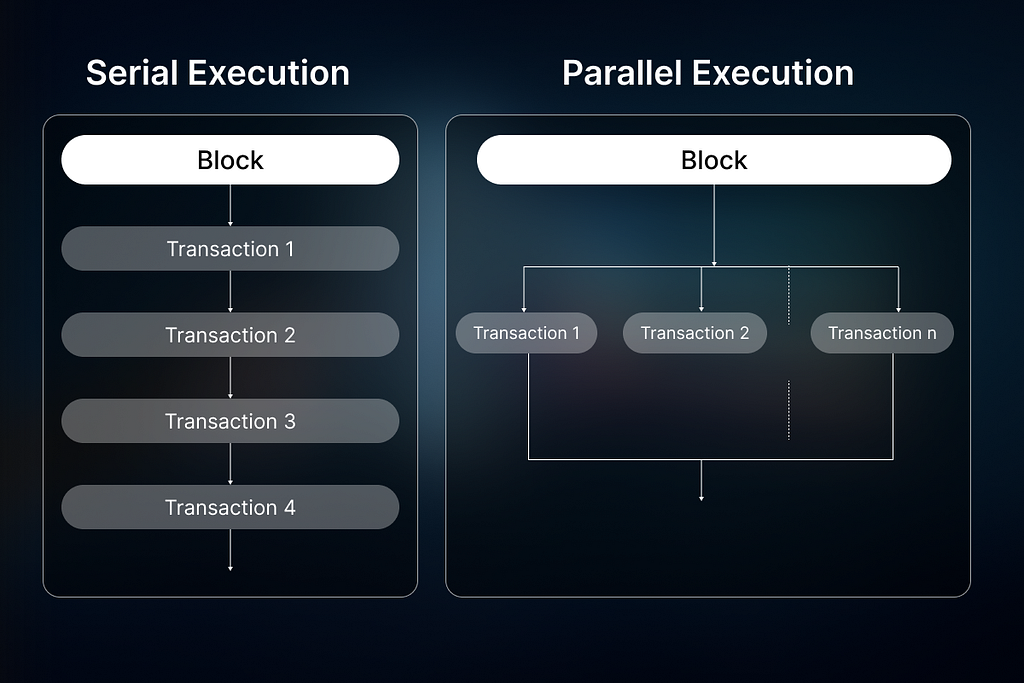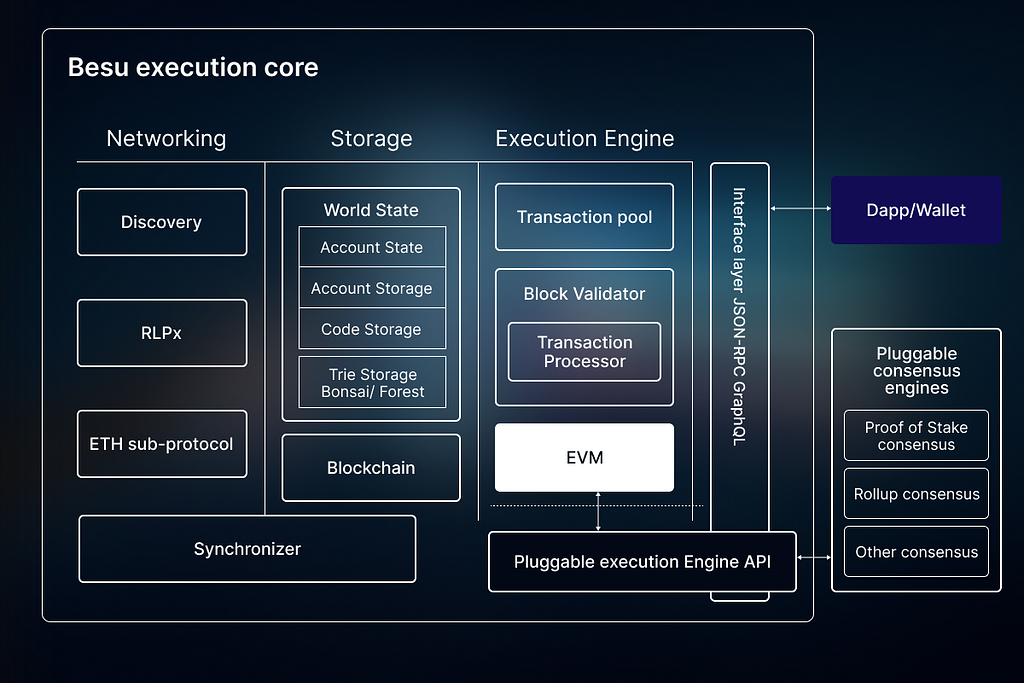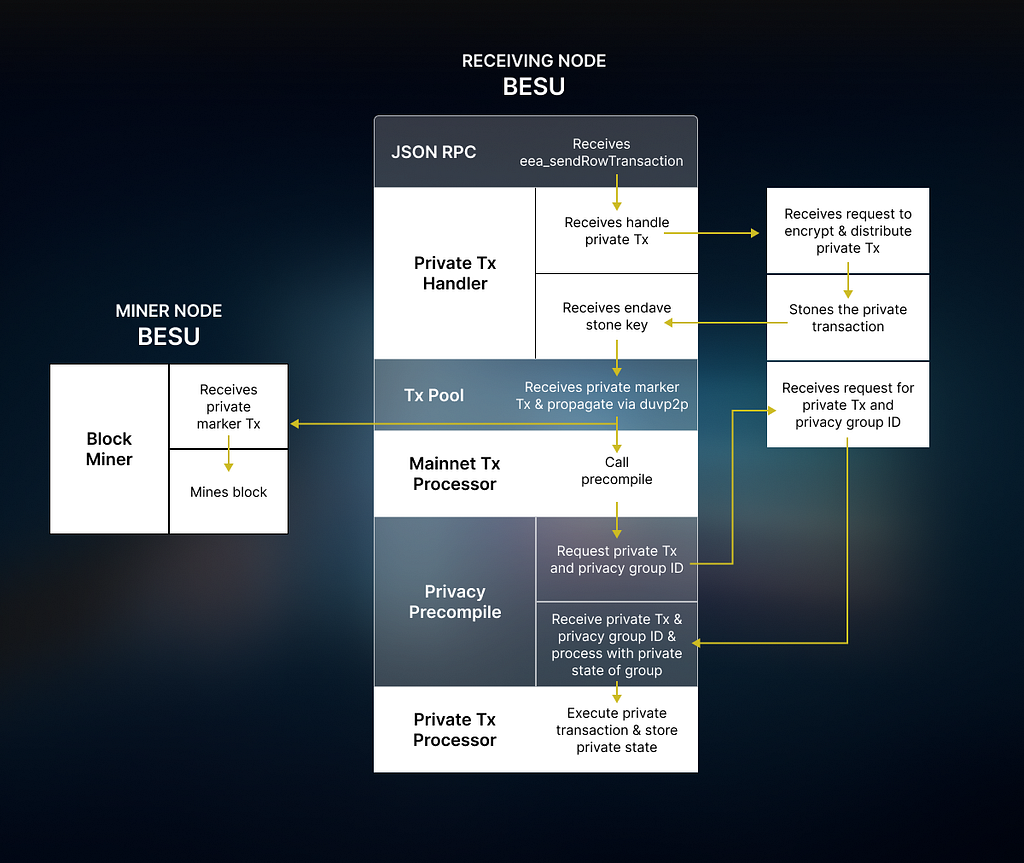
Hyperledger Besu is an open-source Ethereum client developed under the Linux Foundation’s Hyperledger umbrella. It has come up as a promising solution for enterprises looking to tap into blockchain technology. As a modular and versatile platform, Besu facilitates the creation of both public and private blockchain networks, catering to a wide range of use cases.
One of the critical aspects of any blockchain network is its ability to process transactions efficiently, which is directly related to its throughput and latency. Throughput, measured in transactions per second (TPS), determines the network’s capacity to handle a large volume of transactions, while latency refers to the time it takes for a transaction to be confirmed and added to the blockchain.
To address the challenges of transaction throughput and latency, Hyperledger Besu has implemented an innovative approach called parallel transaction execution. This technique allows the network to process multiple transactions concurrently, potentially increasing the overall throughput and reducing latency.
Let’s understand how Hyperledger Besu development implements parallel transaction execution, and explore its underlying mechanisms, potential benefits, and practical implications for enterprise blockchain applications.
Understanding the Challenges of Sequential Transaction Execution
In traditional blockchain architectures, transaction processing follows a sequential model, where transactions are processed one after another in the order they are received. This approach, while straightforward, presents several challenges that can significantly impact the performance and efficiency of the network.
One of the primary issues with sequential transaction execution is the increased block processing time. As the number of transactions grows, the time required to validate and include each transaction in a block can lead to delays in confirmation times. For instance, in Ethereum, the average block time is around 13 to 15 seconds. If a block contains numerous transactions, the cumulative processing time can become substantial, resulting in a sluggish user experience.
Moreover, this sequential model inherently reduces scalability. As transaction volumes rise, the network struggles to keep pace, leading to performance degradation. According to various benchmarks, Ethereum can handle approximately 30 transactions per second (TPS) under optimal conditions. However, during peak usage, this figure can plummet, causing backlogs and delays.
Additionally, the potential for network congestion becomes a significant concern. When many users attempt to submit transactions simultaneously, the limited throughput can lead to increased waiting times and higher transaction fees, further exacerbating the challenges of a sequential processing model. These performance bottlenecks highlight the need for innovative solutions, such as parallel transaction execution, to improve blockchain efficiency.
The Need for Parallelism
The potential performance gains from implementing parallel transaction execution in blockchain networks are substantial. By allowing multiple transactions to be processed simultaneously, parallel execution can significantly improve transaction throughput and reduce latency. For instance, some blockchain systems have reported performance improvements of up to 5 times in transaction processing speeds, indicating that parallel execution can transform how blockchains handle high volumes of transactions.

Various industries stand to benefit considerably from these improvements, particularly those that require rapid transaction processing and high scalability. Use cases include:
- Financial Services: High-frequency trading platforms and payment processing systems can utilize parallel transaction execution to handle thousands of transactions per second, ensuring timely and efficient operations.
- Supply Chain Management: Industries that rely on real-time tracking and verification of goods can utilize parallel execution to optimize processes, reduce delays, and improve transparency.
- Gaming: Online gaming platforms can improve user experiences by processing in-game transactions quickly, allowing for effective interactions and real-time updates.
Real-world applications exemplifying the necessity of parallel transaction execution include:
- Solana: Known for its high throughput, Solana utilizes parallel execution to achieve transaction speeds exceeding 50,000 TPS, making it a leader in the blockchain space.
- Aptos: This platform employs parallel transaction execution to better its transaction processing capabilities, addressing scalability issues that hinder traditional blockchains.
These examples underscore the critical role that parallel execution can play in optimizing blockchain performance across diverse sectors.
Hyperledger Besu’s Approach to Parallelism
Hyperledger Besu employs a modular architecture that allows for efficient parallel transaction execution. At the core of Besu’s transaction processing is the Ethereum Virtual Machine (EVM), which is supported by a transaction processor and a block validator. These components work together to execute transactions concurrently while maintaining the integrity of the blockchain.

Besu’s parallel execution model is based on an optimistic concurrency control approach. This means that transactions are processed in parallel without acquiring locks, and conflicts are detected and resolved at the end of the process. Besu utilizes a conflict detection mechanism that identifies potential conflicts by analyzing the read-and-write sets of transactions. If a conflict is detected, the conflicting transactions are re-executed sequentially to maintain consistency.
To allow for efficient parallel processing, Besu employs specialized data structures and algorithms. The transaction pool, for instance, stores transaction-related information and facilitates concurrent access. The block validator component is responsible for validating transactions and blocks so that they adhere to the consensus rules. By tapping into multiple threads and pipelines, Besu can process blocks and execute transactions in parallel, significantly improving throughput and reducing latency.
Technical Details
To understand how Hyperledger Besu development services execute parallel transactions, it is essential to break down the process into clear, actionable steps. The execution begins when transactions are submitted to the network and enter the transaction pool, where they await processing.
Step-by-Step Breakdown
- Transaction Submission: Users submit transactions to the network, which are collected in the transaction pool. This pool serves as a queue for incoming transactions.
- Transaction Selection: The block proposer selects a batch of transactions from the pool based on predefined criteria, such as gas price and nonce.
- Parallel Execution: Selected transactions are executed in parallel. Each transaction is assigned to a separate thread, allowing multiple transactions to be processed simultaneously. During this phase, Besu uses an optimistic concurrency model to assume that transactions will not conflict.
- Conflict Detection: After parallel execution, Besu analyzes the read and write sets of each transaction to detect any conflicts. If conflicts are found, the conflicting transactions are re-executed sequentially.
- State Transition and Writing: Once all transactions have been processed, state transitions are applied. Besu updates the blockchain state based on the results of the executed transactions so that all changes are consistent and valid.
Transaction Pool Interaction
The transaction pool plays a crucial role in facilitating parallel processing. It allows for efficient transaction management, enabling Besu to quickly access and execute transactions while maintaining order and integrity.
Performance Implications
Different parallelization strategies can considerably impact performance. For instance, fine-grained parallelism, which focuses on executing small, independent transactions, can yield higher throughput compared to coarse-grained parallelism, where larger transactions are processed together. By optimizing the selection and execution of transactions, Besu maximizes its performance capabilities, leading to scalable blockchain solutions.
Besu’s parallel execution model is based on an optimistic concurrency control approach. This means that transactions are processed in parallel without acquiring locks, and conflicts are detected and resolved at the end of the process. Besu utilizes a conflict detection mechanism that identifies potential conflicts by analyzing the read-and-write sets of transactions. If a conflict is detected, the conflicting transactions are re-executed sequentially to maintain consistency.
To allow for efficient parallel processing, Besu employs specialized data structures and algorithms. The transaction pool, for instance, stores transaction-related information and facilitates concurrent access. The block validator component is responsible for validating transactions and blocks so that they adhere to the consensus rules. By tapping into multiple threads and pipelines, Besu can process blocks and execute transactions in parallel, significantly improving throughput and reducing latency.
Technical Details
To understand how Hyperledger Besu development services execute parallel transactions, it is essential to break down the process into clear, actionable steps. The execution begins when transactions are submitted to the network and enter the transaction pool, where they await processing.
Step-by-Step Breakdown
- Transaction Submission: Users submit transactions to the network, which are collected in the transaction pool. This pool serves as a queue for incoming transactions.
- Transaction Selection: The block proposer selects a batch of transactions from the pool based on predefined criteria, such as gas price and nonce.
- Parallel Execution: Selected transactions are executed in parallel. Each transaction is assigned to a separate thread, allowing multiple transactions to be processed simultaneously. During this phase, Besu uses an optimistic concurrency model to assume that transactions will not conflict.
- Conflict Detection: After parallel execution, Besu analyzes the read and write sets of each transaction to detect any conflicts. If conflicts are found, the conflicting transactions are re-executed sequentially.
- State Transition and Writing: Once all transactions have been processed, state transitions are applied. Besu updates the blockchain state based on the results of the executed transactions so that all changes are consistent and valid.
Transaction Pool Interaction
The transaction pool plays a crucial role in facilitating parallel processing. It allows for efficient transaction management, enabling Besu to quickly access and execute transactions while maintaining order and integrity.
Performance Implications
Different parallelization strategies can considerably impact performance. For instance, fine-grained parallelism, which focuses on executing small, independent transactions, can yield higher throughput compared to coarse-grained parallelism, where larger transactions are processed together. By optimizing the selection and execution of transactions, Besu maximizes its performance capabilities, leading to scalable blockchain solutions.

Performance Evaluation and Benchmarking
Evaluating the performance of Hyperledger Besu’s parallel transaction execution is crucial to understanding its advantages over traditional sequential processing. Benchmarks reveal notable differences in throughput and latency, depicting the impact of parallel execution on overall blockchain performance.
Performance Benchmarks
In comparative studies, parallel transaction execution has demonstrated up to a fivefold increase in throughput compared to sequential execution. For instance, while a sequential model might handle around 30 transactions per second (TPS) under optimal conditions, Besu’s parallel execution can achieve rates exceeding 150 TPS, depending on the configuration and workload. These benchmarks highlight the potential for improved performance in environments with high transaction volumes.
Influencing Factors
- Hardware: The underlying hardware, including CPU cores and memory capacity, plays a significant role. Systems with multiple cores can better leverage parallel execution, resulting in improved throughput.
- Network Conditions: Network latency and bandwidth can affect the speed at which transactions are submitted and confirmed. High latency can negate some benefits of parallel execution.
- Transaction Complexity: The complexity of transactions also impacts performance. Simple transactions that do not depend on shared state can be processed more efficiently in parallel than complex transactions that may require more extensive conflict resolution.
Scalability Analysis
Besu’s parallel execution implementation is designed for scalability. As transaction volumes increase, the ability to process transactions concurrently allows the network to maintain performance levels, reducing the likelihood of congestion. However, scalability is not infinite; as the number of transactions grows, the potential for conflicts may also increase, necessitating effective conflict detection and resolution mechanisms.
Potential Performance Optimizations
- Load Balancing: Distributing transactions evenly across available processing threads can minimize bottlenecks.
- Adaptive Parallelism: Dynamically adjusting the degree of parallelism based on current network conditions and transaction characteristics can optimize resource usage.
- Transaction Prioritization: Implementing a prioritization mechanism for critical transactions can ensure that high-priority tasks are processed with minimal delay.
Security and Privacy Considerations
While parallel transaction execution in Hyperledger Besu offers notable performance improvements, it also introduces unique security challenges that must be carefully managed. Understanding these challenges is essential for maintaining data integrity and privacy within the blockchain environment.
Security Challenges
One of the primary security concerns in a parallel execution model is the potential for race conditions, where multiple transactions attempt to access and modify the same state simultaneously. This can lead to inconsistencies in the blockchain state if not properly managed. Furthermore, the optimistic concurrency control model used in Besu assumes that conflicts are rare, which can expose the system to vulnerabilities if a large number of conflicting transactions occur.
Ensuring Data Integrity and Consistency
To address these challenges and ensure data integrity and consistency in a parallel environment, Hyperledger Besu employs a combination of techniques, including atomic state transitions, conflict detection and resolution, and cryptographic verification. By ensuring that state changes are applied atomically and that conflicts are handled correctly, Besu maintains the integrity of the blockchain.
Moreover, Besu utilizes cryptographic techniques to secure transactions and protect against tampering. Each transaction is signed and hashed so that any unauthorized changes can be easily detected.
Privacy Implications and Mitigation Strategies
Parallel transaction execution also raises privacy concerns, particularly in scenarios where sensitive data is involved. The concurrent processing of transactions can inadvertently expose private information if proper safeguards are not in place.
- Data Encryption: Encrypting sensitive data before it is included in transactions can help protect privacy during processing.
- Access Controls: Implementing strict access controls and permissioning mechanisms can limit who can submit and view transactions, reducing the risk of unauthorized access.
- Zero-Knowledge Proofs: Utilizing zero-knowledge proofs can facilitate the verification of transactions without revealing underlying data, improving privacy while maintaining trust.
Future Directions and Research
As the demand for efficient and scalable blockchain solutions continues to grow, Hyperledger Besu’s parallel transaction execution capabilities present numerous opportunities for enhancement and optimization. Exploring these potential advancements can further solidify Besu’s position as a leading platform in the enterprise blockchain space.
Potential Enhancements and Optimizations
- Advanced Conflict Resolution: Developing more sophisticated algorithms for conflict detection and resolution could improve the efficiency of parallel execution. Techniques such as predictive conflict resolution, which anticipates potential conflicts based on historical transaction patterns, could minimize the need for re-execution.
- Dynamic Resource Allocation: Implementing dynamic resource management strategies that allocate processing power based on current network conditions and transaction loads can optimize performance. This could involve scaling resources up or down in real time to meet demand.
- Enhanced Transaction Prioritization: Refining transaction prioritization mechanisms to better accommodate urgent or high-value transactions can enhance user experience and ensure critical operations are executed promptly.
Emerging Trends and Technologies
- Layer 2 Solutions: Technologies such as rollups and state channels are gaining traction as methods to increase throughput while reducing the burden on the main blockchain. Integrating these solutions with Besu’s parallel execution could lead to significant performance gains.
- Machine Learning for Optimization: Utilizing machine learning algorithms to analyze transaction patterns and optimize execution strategies could enhance the efficiency of parallel processing. These algorithms could learn from historical data to improve decision-making in real time.
- Interoperability Protocols: As multi-chain ecosystems become more common, developing interoperability protocols that allow parallel transaction execution across different blockchain networks can improve the flexibility and usability of Besu.
Open Research Questions
- Scalability Limits: What are the theoretical and practical limits of scalability in parallel execution models, and how can these limits be addressed?
- Security Trade-offs: How can security be maintained in highly parallelized environments without compromising performance? What new vulnerabilities might arise from increased parallelism?
- User Experience: How do users perceive transaction finality and confirmation times in parallel execution environments, and what can be done to enhance user trust and satisfaction?
Final Takeaway
Parallel transaction execution in Hyperledger Besu represents a significant leap forward in blockchain performance. By processing multiple transactions concurrently, Besu addresses the scalability and latency challenges that have obstructed the widespread adoption of blockchain technology. The benefits of this approach are evident in improved transaction throughput, reduced block generation times, and enhanced overall network efficiency.
We encourage developers and blockchain enthusiasts to explore the capabilities of Hyperledger Besu firsthand. By experimenting with parallel transaction execution, you can gain valuable insights into its potential applications and contribute to the ongoing development of this open-source platform.
At Codezeros, a leading blockchain development company, anticipate further advancements in parallel execution, leading to new possibilities for high-performance blockchain applications.
How Parallel Transaction Execution Optimizes Hyperledger Besu was originally published in Coinmonks on Medium, where people are continuing the conversation by highlighting and responding to this story.








